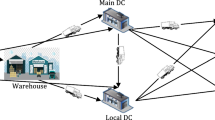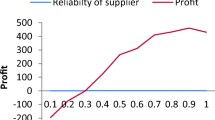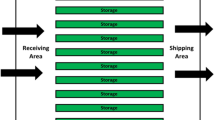Abstract
This paper considers a real case problem of supply chain network design inspired from a wheat distribution network in Iran. It generates a network with capacity acquisition and fleet management. The problem first is formulated as a mixed integer linear programming model. Then, a logic-based Benders decomposition algorithm is appropriately developed as the solution methodology. In the presented algorithm, the problem is decomposed into two models of master and subproblem. The master problem is improved by means of the preprocessing and valid inequalities. Moreover, three Benders cuts, one optimality and two feasibility cuts, are developed for the algorithm. The general and relative performance of the model and algorithm is experimentally evaluated. The wheat distribution system of Iran is considered here as the case study of this research. The model is developed based on Iran’s wheat distribution system. All the results show that the algorithm significantly outperforms the mathematical model of the case study. For example, the algorithm solves 95% of the tested instances to optimality, yet the model solves 29%.






Similar content being viewed by others
References
Afrouzy, Z. A., Nasseri, S. H., & Mahdavi, I. (2016). A genetic algorithm for supply chain configuration with new product development. Computers and Industrial Engineering,101, 440–454.
Agriculture and Horticulture Development Board. (2018). Wheat growth guide, The AHDB WeatherHub. URL https://cereals.ahdb.org.uk/media/185687/g66-wheat-growth-guide.pdf.
Amiri, A. (2006). Designing a distribution network in a supply chain system: Formulation and efficient solution procedure. European Journal of Operational Research,171, 567–576.
Anily, S., & Bramel, J. (1999). Vehicle routing and the supply chain. In S. Tayur, R. Ganeshan, & M. Magazine (Eds.), Quantitative models for supply chain management (Vol. 17). International series in operations research and management science Boston, MA: Springer.
Arabani, A. B., & Farahani, R. Z. (2012). Facility location dynamics: An overview of classifications and applications. Computers and Industrial Engineering,62, 408–420.
Ardalan, Z., Karimi, S., Naderi, B., & Khamseh, A. A. (2016). Supply chain networks design with multi-mode demand satisfaction policy. Computers and Industrial Engineering,96, 108–117.
Arslan, O., & Karaşan, O. E. (2016). A Benders decomposition approach for the charging station location problem with plug-in hybrid electric vehicles. Transportation Research Part B: Methodological,93, 670–695.
Benders, J. F. (1962). Partitioning procedures for solving mixed-variables programming problems. Numerische Mathematik,4, 238–252.
Brown, G. G., & Graves, G. W. (1981). Real-time dispatch of petroleum tank trucks. Management Science,27, 19–32.
Cordeau, J. F., Pasin, F., & Solomon, M. M. (2006). An integrated model for logistics network design. Annals of Operations Research,144, 59–82.
Dai, Z., & Zheng, X. (2015). Design of close-loop supply chain network under uncertainty using hybrid genetic algorithm: A fuzzy and chance-constrained programming model. Computers and Industrial Engineering,88, 444–457.
Delorme, M., Iori, M., & Martello, S. (2017). Logic based Benders' decomposition for orthogonal stock cutting problems. Computers & Operations Research, 78, 290–298.
Devika, K., Jafarian, A., & Nourbakhsh, V. (2014). Designing a sustainable closed-loop supply chain network based on triple bottom line approach: A comparison of metaheuristics hybridization techniques. European Journal of Operational Research,235, 594–615.
Eskandarpour, M., Dejax, P., & Peton, O. (2016). A large neighborhood search heuristic for supply chain network design. Computers and Operations Research. https://doi.org/10.1016/j.cor.2016.11.012.
Fakhri, A., & Ghatee, M. (2016). Application of Benders decomposition method in solution of a fixed-charge multicommodity network design problem avoiding congestion. Applied Mathematical Modelling,40, 6468–6476.
Farahani, R. Z., Hekmatfar, M., Fahiminia, B., & Kazemzadeh, N. (2014). Hierarchical facility location problem: Models, classifications, techniques, and applications. Computers and Industrial Engineering,68, 107–114.
Gholamian, M. R., & Taghanzadeh, A. H. (2017). Integrated network design of wheat supply chain: A real case of Iran. Computers and Electronics in Agriculture,140, 139–147.
Gourdin, E., Labbe, M., & Laporte, G. (2000). The uncapacitated facility location problem with client matching. Operations Research,48, 671–685.
Govindan, K., Soleimani, H., & Kannan, D. (2015). Reverse logistics and closed-loop supply chain: A comprehensive review to explore the future. European Journal of Operational Research,240(3), 603–626.
Govindan, K., Fattahi, M., & Keyvanshokooh, E. (2017). Supply chain network design under uncertainty: A comprehensive review and future research directions. European Journal of Operational Research, 263(1), 108–141.
Gronalt, M., Hartl, R., & Reimann, M. (2003). New savings based algorithms for time constrained pickup and delivery of full truckloads. European Journal of Operational Research,151, 520–535.
Hajghasem, M., & Abbasshojaie, A. (2016). Optimal routing in supply chain aimed at minimizing vehicle cost and supply. Procedia Economics and Finance,36, 353–362.
Hatfield, J. L., & Prueger, J. H. (2015). Temperature extremes: Effect on plant growth and development. Weather and Climate Extremes,10, 4–10.
Hooker, J. N. (2007). Planning and scheduling by logic-based benders decomposition. Operations Research,55, 588–602.
Huang, M., Yi, P., Guo, L., & Shi, T. (2016). A modal interval based genetic algorithm for closed-loop supply chain network design under uncertainty. IFAC-Papers OnLine,49, 616–621.
Jeihoonian, M., Zanjani, M. K., & Gendreau, M. (2016). Accelerating Benders decomposition for closed-loop supply chain network design: Case of used durable products with different quality levels. European Journal of Operational Research,251, 830–845.
Kannan, D. (2018). Role of multiple stakeholders and the critical success factor theory for the sustainable supplier selection process. International Journal of Production Economics,195, 391–418.
Kazemi, Y., & Szmerekovsky, J. (2015). Modeling downstream petroleum supply chain: The importance of multi-mode transportation to strategic planning. Transportation Research Part E: Logistics and Transportation Review,83, 111–125.
Keyvanshokooh, E., Ryan, S. M., & Kabir, E. (2016). Hybrid robust and stochastic optimization for closed-loop supply chain network design using accelerated Benders’ decomposition. European Journal of Operational Research,249, 76–92.
Khatami, M., Mahootchi, M., & Zanjirani Farahani, R. (2015). Benders' decomposition for concurrent redesign of forward and closed-loop supply chain network with demand and return uncertainties. Transportation Research Part E: Logistics and Transportation Review, 79, 1–21.
Khera, R. (2011). Revival of the public distribution system: Evidence and explanations. Economic and Political Weekly, 46, 44–45.
Makui, A., Heydari, M., Aazami, A., & Dehghani, E. (2016). Accelerating Benders decomposition approach for robust aggregate production planning of products with a very limited expiration date. Computers and Industrial Engineering,100, 34–51.
Marufuzzaman, M., & DuniEkşioğlu, S. (2017). Managing congestion in supply chains via dynamic freight routing: An application in the biomass supply chain. Transportation Research Part E: Logistics and Transportation Review,99, 54–76.
Mazzola, J. B., & Alan, W. N. (1999). Lagrangian-relaxation-based solution procedures for a multiproduct capacitated facility location problem with choice of facility type. European Journal of Operational Research,115, 285–299.
Melo, M. T., Nickel, S., & Saldanha-da-Gama, F. (2012). A tabu search heuristic for redesigning a multi-echelon supply chain network over a planning horizon. International Journal of Production Economics,136, 218–230.
Mogale, D. G., Kumar, S. K., Pedro García Márquez, F., & Tiwari, K. M. (2017). Bulk wheat transportation and storage problem of public distribution system. Computers and Industrial Engineering,104, 80–97.
Mostafa, N. A., Eltawil, A. B. (2015). The production-inventory-distribution-routing problem: An integrated formulation and solution framework. In International conference on industrial engineering and operations management (IEOM), Dubai (pp. 1–10).
Pirkul, H., & Jayaraman, V. (1998). A multi-commodity, multi-plant, capacitated facility location problem: Formulation and efficient heuristic solution. Computers and Operations Research,25, 869–878.
Pishvaee, M. S., Razmi, J., & Torabi, S. A. (2014). An accelerated Benders decomposition algorithm for sustainable supply chain network design under uncertainty: A case study of medical needle and syringe supply chain. Transportation Research Part E: Logistics and Transportation Review,67, 14–38.
Poudel, S. R., Marufuzzaman, M., & Bian, L. (2016). A hybrid decomposition algorithm for designing a multi-modal transportation network under biomass supply uncertainty. Transportation Research Part E: Logistics and Transportation Review,94, 1–25.
Riise, A., Mannino, C., & Lamorgese, L. (2016). Recursive logic based Benders’ decomposition for multi-mode outpatient scheduling. European Journal of Operational Research,255, 719–728.
Robles, J. O., Almaraz, S. D. L., & Azzaro-Pantel, C. (2016). Optimization of a hydrogen supply chain network design by multi-objective genetic algorithms. Computer Aided Chemical Engineering,38, 805–810.
Roshanaei, V., Loung, C., Aleman, D. M., & Urbach, D. (2016). Propagating logic-based Benders’ decomposition approaches for distributed operating room scheduling. European Journal of Operational Research. https://doi.org/10.1016/j.ejor.2016.08.024.
Sadjady, H., & Davoudpour, H. (2012). Two-echelon, multi-commodity supply chain network design with mode selection, lead-times and inventory costs. Computers and Operations Research,39, 1345–1354.
Santibanez-Gonzalez, E. D. R., & Diabat, A. (2013). Solving a reverse supply chain design problem by improved Benders decomposition schemes. Computers and Industrial Engineering,66, 889–898.
Schmid, V., Doerner, K. F., & Laporte, G. (2013). Rich routing problems arising in supply chain management. European Journal of Operational Research,224, 435–448.
Shaw, K., Irfan, M., Shankar, R., & Yadav, S. S. (2016). Low carbon chance constrained supply chain network design problem: A Benders decomposition based approach. Computers and Industrial Engineering,98, 483–497.
Soleimani, H., & Kannan, G. (2015). A hybrid particle swarm optimization and genetic algorithm for closed-loop supply chain network design in large-scale networks. Applied Mathematical Modelling,39, 3990–4012.
Soleimani, H., Seyyed-Esfahani, M., & Shirazi, M. A. (2016). A new multi-criteria scenario-based solution approach for stochastic forward/reverse supply chain network design. Annals of Operations Research,242(2), 399–421.
Subramanian, P., Ramkumar, N., Narendran, T. T., & Ganesh, K. (2013). PRISM: Priority based simulated annealing for a closed loop supply chain network design problem. Applied Soft Computing,13, 1121–1135.
Tran, T. T., Araujo, A., & Beck, J. C. (2016). Decomposition methods for the parallel machine scheduling problem with setups. Journal on Computing,28, 83–95.
Verter, V., & Dincer, M. C. (1995). Facility location and capacity acquisition: An integrated approach. Naval Research Logistics,42, 1141–1160.
Wheatley, D., Gzara, F., & Jewkes, E. (2015). Logic-based Benders decomposition for an inventory-location problem with service constraints. Omega,55, 10–23.
Zarandi, M. H. F., & Beck, J. C. (2011). Using logic-based benders decomposition to solve the capacity and distance constrained plant location problem. INFORMS Journal on Computing,24, 387–398.
Zhalechian, M., Tavakkoli-Moghaddam, R., Zahiri, B., & Mohammadi, M. (2016). Sustainable design of a closed-loop location-routing-inventory supply chain network under mixed uncertainty. Transportation Research Part E,89, 182–214.
Zhang, S., Lee, C. K. M., Wu, K., & Choy, K. L. (2016). Multi-objective optimization for sustainable supply chain network design considering multiple distribution channels. Expert Systems with Applications,65, 87–99.
Zohal, M., & Soleimani, H. (2016). Developing an ant colony approach for green closed-loop supply chain network design: A case study in gold industry. Journal of Cleaner Production,133, 314–337.
Acknowledgements
The first author thanks the boards of Kharazmi University, especially the Research Deputy, for their support during his sabbatical period.
Author information
Authors and Affiliations
Corresponding author
Additional information
Publisher's Note
Springer Nature remains neutral with regard to jurisdictional claims in published maps and institutional affiliations.
Rights and permissions
About this article
Cite this article
Naderi, B., Govindan, K. & Soleimani, H. A Benders decomposition approach for a real case supply chain network design with capacity acquisition and transporter planning: wheat distribution network. Ann Oper Res 291, 685–705 (2020). https://doi.org/10.1007/s10479-019-03137-x
Published:
Issue Date:
DOI: https://doi.org/10.1007/s10479-019-03137-x




